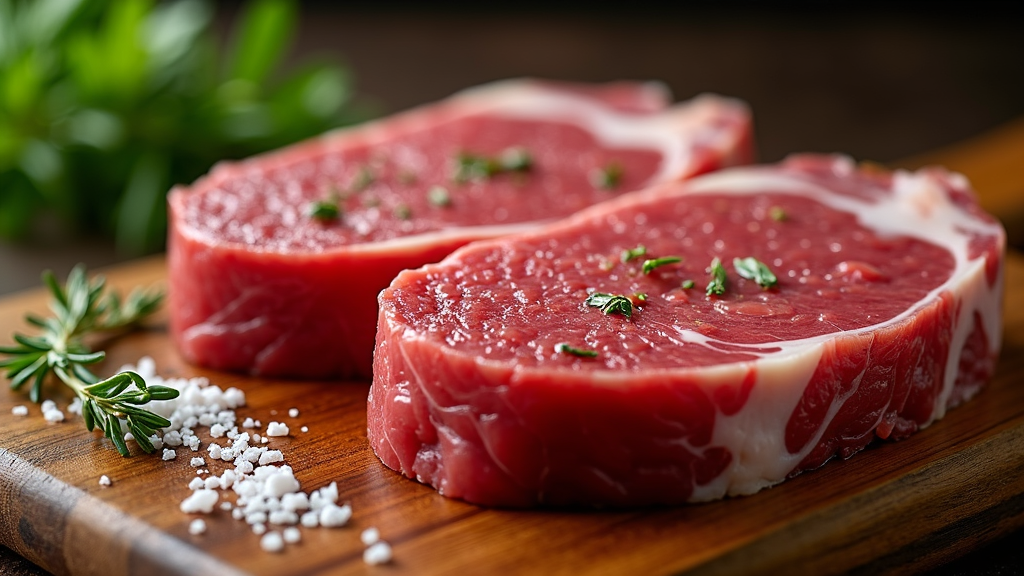Few foods spark as much curiosity—and debate—as Wagyu beef. When you hear about it, images of beautifully marbled steaks and sky-high price tags probably come to mind. But does it actually deliver on all that buzz, or is the hype just clever marketing? I’m breaking down what makes Wagyu beef so talked-about, where it comes from, how it stacks up taste-wise, and if it lives up to its reputation and price.

Why Is Everyone Talking About Wagyu Beef?
Wagyu beef has become a superstar in food circles because of its insane marbling and rich flavor. “Wagyu” basically means “Japanese cow,” but true Wagyu refers to specific cattle breeds raised using very particular methods. Those tiny white streaks of fat, marbling, show up way more in Wagyu than in regular beef. They’re not just for looks; they melt at low temperatures, making each bite buttery and tender, with a silky mouthfeel that’s unlike any other steak.
The demand for Wagyu, especially in the U.S. and Europe, has exploded over the last decade. You’ll see Wagyu on high-end restaurant menus, Instagram feeds, cooking shows, and even in burger form at specialty shops. Premium Japanese Wagyu commands prices well above other beef, sometimes hundreds of dollars for a single steak.
The Basics: How Wagyu is Raised and Graded
There’s a whole set of strict rules around authentic Wagyu. In Japan, only four breeds make the cut: Japanese Black, Brown, Shorthorn, and Polled. These cows are raised with a ton of attention, with controlled feed, stress-free environments, and health monitoring. Their diet might include rice straw, corn, and barley, all chosen to boost marbling and keep the cows healthy.
The grading system for Wagyu is wild. In Japan, the beef gets two scores: one for yield (A–C), the other for quality (1–5). “A5” Wagyu is the absolute top, with next-level cool marbling, color, and texture. You’ll find lower-graded Wagyu and “crossbred” beef, but genuine Japanese A5 is rare outside Japan and comes with certificates proving its origin.
What Makes Wagyu Beef So Unique (and Pricey)?
The most obvious difference is the fat marbling, but there’s more going on. Wagyu cattle have genetics that naturally produce softer, more flavorful fat. This fat melts at a lower temperature, making the beef taste almost sweet, with a texture that’s super tender. Chefs and food lovers go nuts for the way it delivers flavor with every bite.
Raising Wagyu can’t be rushed. These cattle often grow for three years or longer, much longer than typical beef cattle, on carefully managed feeding programs. All that time and care means higher costs all the way down the chain. Add strict regulations, import duties, and limited supply, and it’s easy to see why prices stay high.
How Wagyu Tastes in Real Life
Eating Wagyu for the first time is an experience a lot of people remember for years. The beef is crazy tender and melts in your mouth with a burst of rich, buttery flavor. It’s not “meaty” the way some cuts are. It almost feels like steak meets foie gras. Even seasoned steak lovers are usually surprised by how rich a small bite can be. For me, just a few ounces feel satisfying, especially compared to eating a big ribeye or porterhouse.
Different grades and breeds have subtle flavor differences. Authentic Japanese A5 is so rich with umami you might want to pace yourself. American and Australian Wagyu producers have leaned into crossbreeding to balance marbling with that bold, beefy flavor some people expect, so these steaks can hit differently than the ultra-rich Japanese stuff.
Is Wagyu Beef Actually Healthier?
While Wagyu looks fatty, its fat profile is a bit different from standard beef. Wagyu is higher in monounsaturated fats, which some studies suggest can be better for your cholesterol compared to regular beef. There’s also more omega-3 and omega-6 fatty acids. That said, it’s still beef and still high in calories, so I treat it like an occasional treat, not an everyday food.
Some health professionals argue that the fat quality may have minor benefits, but there isn’t enough evidence yet to say Wagyu is a health food. If you’re watching your fat intake, even high-quality Wagyu should be savored in small amounts.
Is Wagyu Worth the Price?
This is where things get personal. If you love exploring new flavors or savoring top-quality steak, Wagyu feels worth the splurge for a special meal. The texture and flavor can’t really be matched by supermarket steak, especially if you’re trying real Japanese Wagyu. For foodies or anyone after a one-of-a-kind eating experience, it’s pretty hard to beat.
For everyday eating? I stick to my usual aged steaks or good grassfed beef. The price difference is pretty steep, so I save Wagyu for birthdays, anniversaries, or when friends come over for something next-level cool.
What to Watch Out For When Buying Wagyu
- Fake Wagyu and misleading labels: Not everything called “Wagyu” is the real deal. Many places sell crossbred or “Wagyu style” beef that isn’t authentic Japanese Wagyu. Check for certificates or ask for proof if you’re paying top dollar.
- Know your grades: Don’t assume every cut is A5. Read the label or ask questions. Sometimes restaurants or butchers use “Wagyu” loosely for beef from crossbred cattle.
- Overcooking risks: Wagyu fat melts fast, so it’s best cooked medium rare or even rare. Too much heat and you’ll lose the texture and burn off the amazing marbling you paid for.
- Price checks: Shop around and compare. A good local butcher or steakhouse specializing in highend beef will be up front about what they’re selling and where it comes from.
Misconceptions About Wagyu Beef
A lot of people believe all Wagyu is created equal, but that’s not the case. True Japanese Wagyu is different from American or Australian raised Wagyu, which often comes from crossbred cattle. The experience can be great either way, but the flavors, fat content, and prices can be worlds apart. It’s also worth knowing that some stores and even restaurants lean on the “Wagyu” name for marketing when it’s not the same as real-deal, certified beef from Japan.
Cooking Tips for Wagyu Newbies
- Keep it simple: A little sea salt and a hot skillet works best. Over seasoning can hide the flavor.
- Watch the heat: Cook quickly and don’t overdo it. Sear, don’t bake or grill over a strong flame.
- Keep servings small: Wagyu is super rich, so a few ounces will go a long way.
Wagyu vs. “Normal” Beef
- Marbling: Wagyu has way more marbling, making it juicier and more tender than almost any other beef.
- Flavor: Wagyu has a sweet, buttery taste from the unique fat, compared to the stronger, beefier notes of regular steak.
- Cost: Wagyu costs a lot more per pound. This makes sense once you realize all the work that goes into producing it.
Trying Wagyu after a lifetime of standard grocery store steak is a pretty cool eye opener. The difference is more pronounced the higher the grade.
Common Questions About Wagyu Beef
What’s the difference between Kobe and Wagyu?
Kobe beef is Wagyu from a specific region (Hyogo Prefecture in Japan) and breed (Tajima Japanese Black), with some of the strictest rules you’ll find. All Kobe is Wagyu, but not all Wagyu is Kobe. Kobe is even rarer and usually pricier.
Where can you actually buy real Wagyu?
Authentic Japanese Wagyu is imported and regulated, so go to reputable butchers or specialty retailers. Look for certificates of authenticity. Some steakhouses with Japanese partnerships serve it by the ounce for those just wanting to try a bite.
Is American or Australian Wagyu just as good?
Some American and Australian Wagyu rivals the best, but it’s usually a crossbreed for slightly less marbling and a bolder, beefier profile. It’s delicious, but still different from certified Japanese A5.
Do you have to cook Wagyu differently?
Yes, Wagyu’s lower melting point means gentle handling. Just a quick sear on each side. Don’t flame grill or cook until well done, or you’ll miss the texture that makes it special.
Personal Experience: My Take On Wagyu Beef
My first experience with real Japanese A5 Wagyu was at a tiny steakhouse. The chef cooked it tableside, sliced paper thin. With just a sprinkle of salt and another with a touch of wasabi, it only needed a few seconds on the grill. It’s one of the only steaks I’ve had where each bite felt like a whole meal, thanks to the intense, rich flavor. I walked away thinking it was hands-down the best steak I’d ever eaten, though I couldn’t imagine eating a giant Wagyu steak in one go; much richer than classic steaks I grew up on.
Since then, I’ve had the chance to try Wagyu from the US and Australia, and while they impressed me with how tender and flavorful they were, nothing quite matched the silkiness of real Japanese A5. Still, it’s a blast to try different types, and it’s always a conversation starter with friends who want to check out what all the hype is about. In my opinion, sampling even a small amount leaves a lasting memory. If you’re passionate about food, giving Wagyu a shot, even just once, is definitely something to add to your adventure list.
Final Thoughts: Is Wagyu Worth It?
If you’re looking for a splurge meal or a new adventure for your taste buds, Wagyu is absolutely worth checking out. It probably won’t replace traditional steak for most people, and it’s not necessary for an amazing meal every week. But for those big moments, dates, or food adventures, Wagyu really does live up to much of the hype. Just be sure you’re getting what you pay for, start with a small portion, and let the flavor do its thing.
For more details, you can check out the American Wagyu Association (wagyu.org) and read about the grading system used in Japan on the Japan Meat Grading Association’s website.
